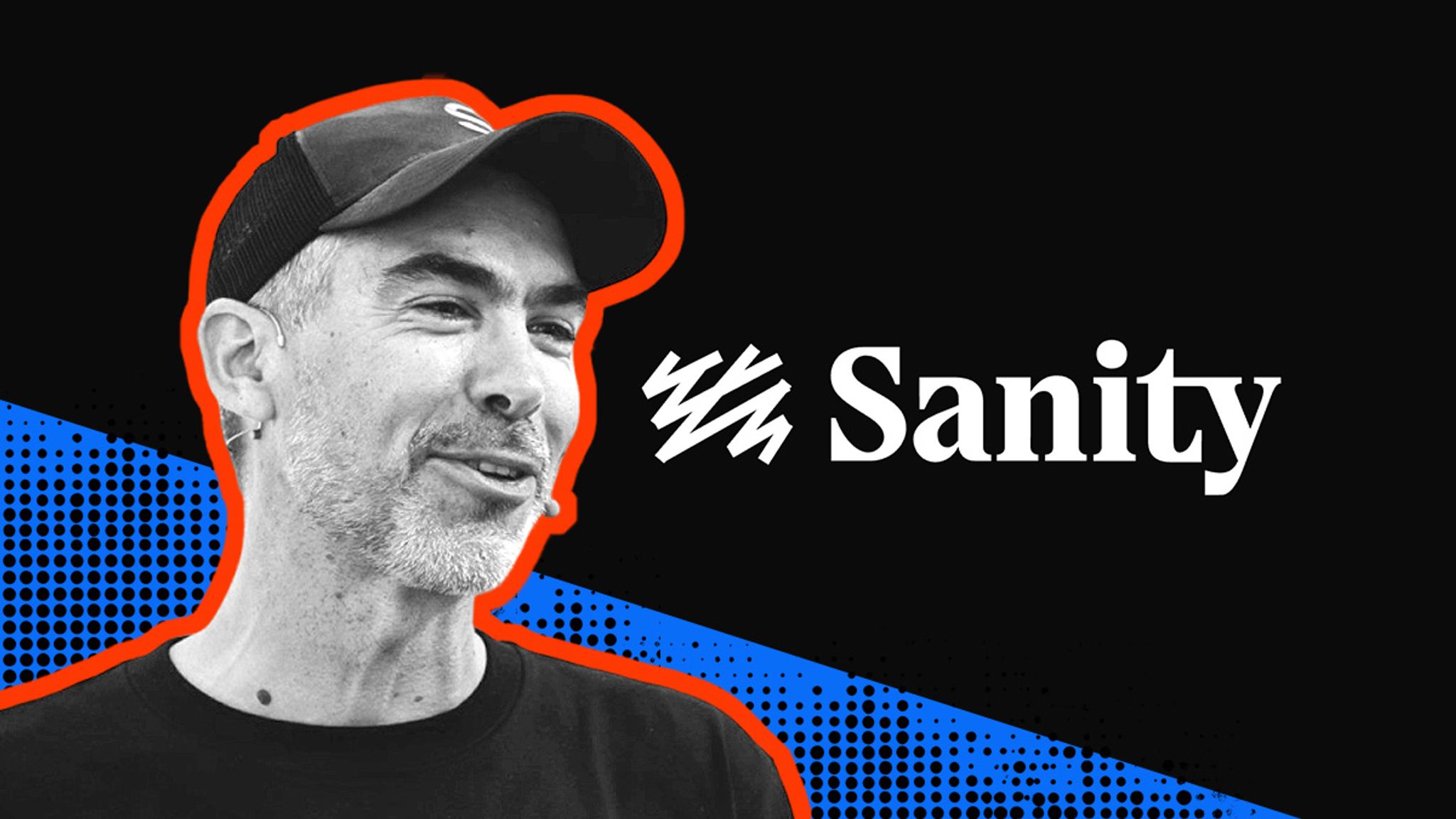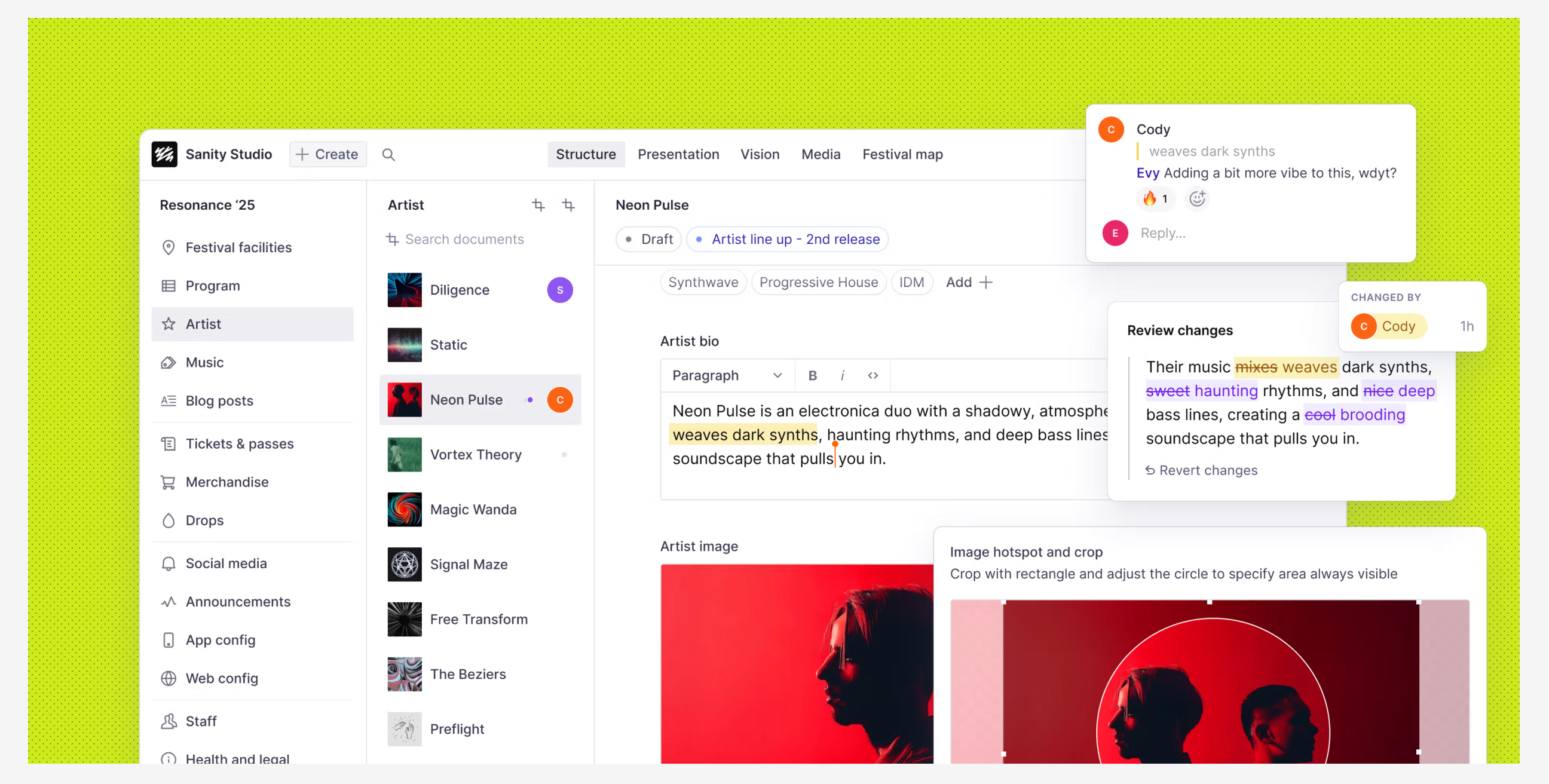Sanity says CMSes are broken. Is its 'Content Operating System' the next evolutionary step?

CEO and co-founder Magnus Hillestad thinks so – and he has 85 million reasons to back it up. As the company closes a heady Series C, it aims to deliver on the promise of content as a strategic asset for modern multi-modal businesses.
When I spoke to Magnus Hillestad last week, he was exploding with excitement.
And why not? Sanity, the company he co-founded in 2018, had just closed an $85 million Series C, a winfall for any tech business in this economic climate. The injection follows a robust $39 million infusion in 2021 and reinforces a healthy trend of investor confidence.
But the real juice in his battery? That was coming from the launch of Sanity’s first complete version of its “Content Operating System,” an engineering platform built on the core concept that content is data, and data can shape how your business operates at scale.
This isn’t a new vision, mind you. I’ve been following Sanity’s progress along this novel horizon since the idea was first telegraphed to the market, reflected in a series of incremental moves.
Case in point: Last November, the company bought the team behind Begin.com, which specialized in deploying full-stack web apps to AWS. This was a strategic block in the foundation for scalability, delivery, and automation that accelerated the roadmap for fulfilling this idea of a holistic Content Operating System.
Introducing a new term (or a three-lettered acronym) is balancing act. We can all agree that the fabric of our industry categories is beyond frayed, and buyers already struggle with understanding the landscape. Last week at the Boye & Company CMS Experts meeting in New York, we brushed over this age-old question of whether a DXP is worthy of being a category at all – something Tony Byrne of Real Story Group pondered back in 2017.
To be clear, Sanity delivers many of the same expected functions as a headless content management system. It’s an API-first platform, and its Sanity Studio is still pitched as a CMS with visual editing capabilities. But as Magnus contends, it doesn’t quite fit into a CMS or DXP definition, at least not squarely.
“I think we're not a headless CMS,” he said with gusto. “Of course, we have an API, but we’ve never kind of been that, right? We started calling ourselves a ‘Content Operating System’ in the fall. This is all part of this process.”
“I think we're not a headless CMS. Of course, we have an API, but we’ve never kind of been that, right?"
Arguably, going against the grain has worked to Sanity's advantage. It has consistently given its customers a new lens for viewing its entire content platform – and that’s a big reason why they’ve attracted global brands like Expedia, Figma, Burger King, and Riot Games to the fold. Perhaps developers are seeking them out because they’re hungry for something more.
The persistent category confusion might be one of the biggest challenges as Sanity embarks on this journey to redefine its space. But selling the vision doesn’t seem to concern Magnus. He and co-founder Simen Svale Skogsrud – who I’ve spoken to previously about Sanity’s differentiated value – are passionate about this evolution to something more than a CMS.
For Magnus, there’s also a deeper motivation to solve the many failures he sees with modern content management systems. In his mind, we’re at a pivotal moment of change, and he has boldly proclaimed that “The age of the CMS is over.”
Yes, it’s a frothy, provocative statement – though not nearly as contentious as, say, Preston So’s “Death of the Pure Headless CMS” or Darren Guarnaccia’s “The Death of DXP.” Still, it’s meant to charge the conversation, and it achieves that in spades.
There’s no question that Sanity’s vision has delivered confidence to its investors, and it seems to be resonating around the broader business considerations. Magnus makes a strong case for why the ecosystem of CMS choices aren’t measuring up, but does his vision of a Content Operating System represent the next evolutionary step?
Mending the broken promises of CMS
Magnus penned a thoughtful post about the Series C announcement, and it’s worth a read. In it, he chronicles the rise of legacy CMS platforms for specific use cases, from marketing to media to publishing. As he suggests, many platforms are indeed replete with rigid structures, limiting their overall adaptability and scalability.
In the article, Magnus also emphasizes that many CMSes still offer "one-size-fits-no-one workflows," prioritizing templates over customizable, scalable solutions. This approach can lead to frustration as businesses evolve, and their content needs become more complex.
Most of us in the content field have gotten an earful from users about why they hate their CMS, and many of these factors have come into play. Recently, Sanity asked its community on X why more people aren’t angry with their current platform. Based on their feedback, it seems that most users are beyond the animus and in deeper stages of grief and acceptance.
Funny… but also not funny.
Sanity's Content OS vision is attempting to redress the perceived dissatisfaction by centralizing content operations. The platform's emphasis on structured content also allows for greater reusability and adaptability, aligning with the needs of enterprises seeking to deliver consistent digital experiences across modern multi-modal and omnichannel strategies.
CMSes are generally under pressure as features have become more commoditized. We've seen the “race to the middle” result in composed and headless platforms finding greater parity, trying to establish value around enhanced usability. Now, as we enter an era of low-code, no-code, and vibe-code creation, organizations are requiring even more flexibility from their tools.
As Magnus said, the best businesses have already started this transformation, and their ability to grow is directly tied to how effectively they can leverage data and efficient processes to create new products and experiences. The blocker: legacy systems aren’t designed to deliver the next level of customer experiences, or provide faster delivery to meet future demand.
Enter the ‘Content Operating System’
Obviously, the notion of a Content Operating System plays on established software lexicon, giving it a more holistic relatability. That’s clearly by design, and telegraphs a more foundational concept that even encompasses business considerations.
Case in point: Love Holidays, a travel agency in the UK, manages the configuration of its support call line through Sanity. These successful use cases illustrate the platform's broader potential for powering applications beyond just a CMS.
At it core, Sanity's Content OS aims to centralize content operations. This is architecturally composed of its keystone Sanity Studio, an all-code content workspace built for data stores within its Content Lake database.

Sanity Studio. Source: Sanity website.
It’s worth noting that Sanity Studio is still clearly positioned as a headless CMS. It provides a developer-first authoring surface for defining content models via code and versioning with Git. This ecosystem is designed to support flexible workflows, enabling teams to create, manage, and distribute content more efficiently.
The platform's emphasis on structured content also allows for greater reusability and adaptability, aligning with the needs of modern enterprises seeking to deliver consistent digital experiences across multiple channels.
As I previously mentioned (and covered), Sanity acquired the team assets of Begin.com last November, a company specializing in deploying full-stack web apps to AWS. I connected with Magnus at the time, and he explained how this shift was reinforcing his vision for a Content Operating System by simplifying aspects of deployment.
“The Begin Team's experience building within a 'cloud hyperscaler' environment provides substantial value to our customers through the development of powerful compute capabilities,” Magnus said, “which simplifies the way they build complex content automations. The goal is to enable our customers to easily deploy content operations applications directly on the Sanity Content Operating System, abstracting away much of the complexity.”
The assimilation of Begin's expertise hinted at Sanity's evolution beyond traditional CMS parameters. It focused on delivering a comprehensive content solution that addresses the dynamic needs of modern businesses, including the critical infrastructure requirements to sustain them.
Evolving for engineers
As Magnus explained, Sanity is enriching its offering with the completion of its engineering platform – adding an SDK, runtime, and native AI functions (more on that last piece in a minute). This empowers developers to build business logic into their content ops and deploy more advanced applications and use cases.
“For us, content operations isn't just a website,” Magnus injected. “Sure, Figma uses Sanity for its site. But remember that the point-of-sale system for Burger King is also powered by Sanity, right? Riot Games uses Sanity for both its website and its League of Legends.”
How flexible is this proving? Just a few weeks ago, Sanity held a hack-a-thon in New York City with its customers, including the MoMA. Teams worked with Sanity engineers to build content operations applications using its new SDK, showcasing the platform's flexibility and engineering capabilities.
“Sanity has always been much wider than a CMS, and now we’re an engineering platform,” said emphatically. “Everything else is just marketing applications and point-and-click solutions with code extensions on them. Our engineers can build much more.”

Sanity Media Library. Source: Sanity website.
But it’s more than just engineering – it’s a blend of tools that support content ops. Reflecting this, Sanity introduced a few other notable features with its Series C announcement, including a Media Library for managing images, and Canvas – and AI-powered tool that turns free-form writing into structured content.
Enhancements have also been made to observability within Sanity’s Dashboard to unify content applications and provide insight into various content operations.
Tapping native AI integration
As Magnus noted in his announcement, AI is changing the game, rendering developers more efficient and capable of building complex solutions – even making code the “new no-code” for less technical people. That said, AI isn't a silver bullet, and still requires strong internal competencies at the intersection of technology and business development.
One of the big revelations Magus focused on is how Sanity is becoming an AI native platform, which is powering the horizon of agentic AI capabilities. As he shared with me, Sanity was already innovating around AI services – including its built-in Sanity AI Assist, which offers a deep knowledge of a company’s unique content strategy. Users have access to an intuitive UI for writing and sharing prompts, and Sanity’s customers have been gravitating towards this feature.
Now, thanks to the platform’s open nature, customers are building their own workflows with AI, connecting directly via APIs to Anthropic or OpenAI. This is being further augmented by the recent launch of Sanity’s Model Context Protocol (MCP) server, which enables AI agents to interact with your content using powerful tools for document management, GROQ queries, and more.
Sanity’s Agent Actions also provide greater potential for automation and experience creation. This level of customization is part of the strategic appeal, and it gives users more control over how AI can be harnessed in workflows.
“We're now launching AI Actions, which are our abstracted LLMs for content operations,” Magnus said. “And with those actions, and also with MCP server if you want to use it in between, you can actually put AI into your workflows.”
The road ahead: Is a COS the fix we need?
I just wrapped a week in Frankfurt at the Boye & Company CMS Summit 25, where I spoke about the undeniable evolution in the CMS market. There are internal and external forces at play, with pricing and licensing models being disrupted and IT budgets slashed. Trade wars and market uncertainty have weighed heavily, and we’ve even seen shakeups in leadership.
Several vendors I spoke with echoed these challenges, as did agencies and builders who are trying to divine the real trends – and where content management is headed.
Are CMSes broken? It depends on your perspective. We can all agree that every platform could use improvement, but Magnus raises some interesting points about the limitations of legacy thinking that didn't position content at the core of a business. Maybe we weren't ready for that shift in mindset until now.
Injecting a new position into an established market is always fraught with risk, but Sanity’s vision of a Content Operating System seems to be expanding on the best parts of the CMS foundation. One of the key distinctions is how Sanity is enriching content as a core business asset and providing engineering capabilities to build applications that serve broader business goals.
Obviously, there’s a developer-centricity at the heart of Sanity's mission, and that continues to be expressed in its messaging. The promise is clear: greater control and adaptability at a time when agentic AI is driving nearly all new innovation. As that trend continues, Sanity is posturing to be a default choice among content platforms that are designed for this AI motion.
“I think the gravity is going towards technology, especially now, because ‘code’ just became ‘no code,’ right?” he said. “Everybody's looking at how you use LLMs to build with code, without knowing code, and ask any LLM what CMS it prefers to build with. So CMS is a natural on-ramp for an evolution of an industry.”
Driving demand for its Content Operating System will require ambition and resolve, especially in a market that’s mired by confusion. We’re still wrestling with the category conundrum surrounding headless CMSes, composable DXPs, and other terminology. Do we really need another name or acronym added to the mix?
The short answer is yes – but only if it helps clarify things for customers.
Competing against legacy players won’t be an easy hill to climb. Most CMSes have achieved parity from a features perspective, and everyone is doubling down on the development of MCP servers and agentic AI capabilities.
But Sanity has already built significant traction, and as businesses continue to seek agile and scalable content solutions, its vision for a Content Operating System could very well cut through the commodity messaging and catch fire with a broader audience.
Much of Sanity’s success will rest with its community of builders and the leaders shaping the trajectory. Both Magnus and Simen are curious explorers, and they appear together in an endearing video that crystallizes their passion for what’s ahead. It’s a fun look at the people driving the technology, and another reason why you should pay attention to their progress:
Upcoming Events

Contentstack ContentCon 25
June 3-5, 2025 – Chicago, USA
The future of digital is waiting for you! Contentstack presents ContentCon, the premier event for digital teams and industry leaders who are reimagining the future of digital experiences. Join us for two days of transformative presentations and workshops designed to help you put personalization and AI strategies into action. Register today!

CMS Connect 25
August 5-6, 2025 – Montreal, Canada
We are delighted to present the second annual summer edition of our signature global conference dedicated to the content management community! CMS Connect will be held again in beautiful Montreal, Canada, and feature a unique blend of masterclasses, insightful talks, interactive discussions, impactful learning sessions, and authentic networking opportunities. Join vendors, agencies, and customers from across our industry as we engage and collaborate around the future of content management – and hear from the top thought leaders at the only vendor-neutral, in-person conference exclusively focused on CMS. Space is limited for this event, so book your seats today.